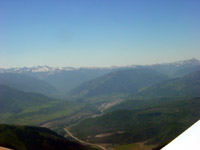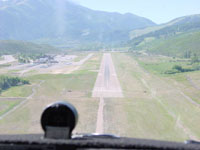FergWorld : Articles : Mountain Flying

By Ryan Ferguson
(cont'd from page 3)
The route
 |
 A flatlander's view of the terrain in the Rockies. What beautiful, but inhospitable terrain; it commands awe and respect. Yeah, I know I need a shave, but I'm on vacation!
A flatlander's view of the terrain in the Rockies. What beautiful, but inhospitable terrain; it commands awe and respect. Yeah, I know I need a shave, but I'm on vacation! |
Our route today takes us through several mountain passes and betwixt the peaks surrounding us. The lowest enroute altitude I'll fly is 9,000 feet, and that is definitely low, in many cases only 500 feet or so AGL. We are more commonly between 12 and 13 thousand feet.
The first airport we land at is Granby, and it's my first true 'high altitude' airport on this trip aside from landing in Boulder, which is a mere 5,200 feet above sea level. Granby is up at 8,200 feet, and it's a warm day: the density altitude is in the neighborhood of 10,500 feet. As we approach the airport, I remember a day in Florida when I couldn't even get a tired, old, max-gross Piper Arrow up to 10,000 feet. As I roll out on final I realize I'm too high, but not too fast; I put the TwinCo into a full-control deflection slip and level the wings on short final, 100mph indicated, but the ground is moving by very quickly. I'm already congratulating myself on getting down in time when the airplane reminds me not to get cocky, and I bounce along the runway a couple of times as a result of landing a bit too flat.
 |
 |
|
Aspen (ASE) airport, elevation 7,820 feet and surrounded by terrain. Now that you've seen the terrain, check out the VOR-DME or GPS-C, and then decide whether you'd ever want to fly the missed approach. |
Next up, we hit Kremmling, followed by an airport I was particularly keen to fly into: Aspen. Aspen was the focus of intense media interest following the crash of a Gulfstream attempting to land after dark, shooting an instrument approach that was not authorized for the time of day, or even for the class (Class D) approach minimums that the aircraft would qualify for. As we came around the mountain hiding Aspen from the world, we saw where the Gulfstream went in. It was heartwrenching: they were so close, literally a couple of hundred feet from the runway threshold. After seeing the area surrounding the airport in good day VFR conditions, I couldn't fathom ever being willing to shoot the approach in IMC in my underpowered little airplane. It's simply not feasible, and though it may be legal, I don't believe it's safe.
"High elevation operations aren't dangerous; they're different, and they really do require special training. Sufficiently trained, a safety-minded pilot will do just fine in the high country."
Next up was Leadville, touted as North America's highest elevation airport. At 9,927 feet, Leadville is no slouch! And with warm temperatures, density altitude at field elevation was - are you ready? - 12,600 feet! As we approached the field a Cherokee was circling to gain altitude after departure. He had a long way to go, and I guessed that even with low fuel and two people aboard he wasn't getting more than 100-200fpm climb rate at the most.
|

Incredible pan view of Leadville airport and surrounding terrain. Taken (and ©) by my friend David Knapp, who landed this 180 horsepower Cessna 172SP here on a warm day!
|
Landing at Leadville was actually much easier than Aspen since the airport is located in the midst of a vast valley with plenty of room to maneuver. The FBO operator, Dan, was quite friendly. In short order we had fuel, the requisite T-shirts and certificates touting our achievement. Okay, so it wasn't quite as difficult as I expected, but I'd learned a lot already by this time, and had the CPA to thank for that. High elevation operations aren't dangerous; they're different, and they really do require special training. Sufficiently trained, a safety-minded pilot will do just fine in the high country.
Returning back to Boulder through the mountain passes, I worked the upwind side of the valleys for lift when I needed it. Consistently, it was there, and I'd go from 300fpm to 1,200fpm with a gentle bump from below that was the telltale sign of an updraft. Similarly, if a valley is sunlit on one side and shaded on the other, the sunny side will usually give you lift, all other things being equal. Mark, a glider pilot in addition to holding an ATP certificate in both single and multiengine land and seaplanes, explained how much he learned about flying from gliders. Sign me up - I can't wait!
We landed and debriefed. I'd learned so much, not only about mountain flying but the capabilities of my airplane and myself. My plan was to depart Boulder for Telluride the following day - a trip I made with confidence thanks to my newfound knowledge. Rather than filing IFR and 'getting above it all,' we stayed down in the valleys and enjoyed the scenery rolling around us on all sides. Fantastic stuff. Next: Conclusion and Salient Points.
Click here for page 5 »
|

